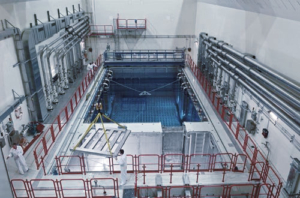 Managing spent nuclear fuel after its removal from reactors is one of the most crucial issues in the fuel cycle. At present, 6,500 t of spent fuel is removed from 438 reactors around the world every year (ref. IAEA, incl. Japan). Some 385,000 t was removed between 1970 and 2015 and, according to IEA forecasts based on a +2°C scenario, 700,000 t of fuel will have been unloaded over the period from 1970 to 2040 (ref. World Nuclear Outlook 2014).
Managing spent nuclear fuel after its removal from reactors is one of the most crucial issues in the fuel cycle. At present, 6,500 t of spent fuel is removed from 438 reactors around the world every year (ref. IAEA, incl. Japan). Some 385,000 t was removed between 1970 and 2015 and, according to IEA forecasts based on a +2°C scenario, 700,000 t of fuel will have been unloaded over the period from 1970 to 2040 (ref. World Nuclear Outlook 2014).
On removal from the reactor, spent fuel assemblies are stored to cool in the spent fuel pool. From there, they are either disposed of directly in underground disposal facilities, having first been conditioned to meet international requirements regarding the final disposal of radioactive waste, or sent to fuel reprocessing plants, where material that can be recycled is separated out, and the unwanted residue conditioned for final disposal.
Spent fuel can remain in the spent fuel pool for many years – if not decades – before being shipped for final disposal. During this time, large quantities of spent fuel wait in long-term storage facilities before being sent to reprocessing plants or waste disposal facilities. During this period, IAEA safety requirements must be met and containment integrity guaranteed to ensure that the population and environment are fully protected against the risk of radiation exposure and contamination.
Long-term storage of irradiated material
Long-term storage began a few decades ago with wet storage, i.e. storing irradiated material in pools. This method is safe and perfectly controlled by operators and ensures that the behaviour of spent fuel assemblies and material containers is closely monitored. It does, however, involve the use of mechanical and hydraulic equipment that calls for constant, high-level human support.
More recently, wet storage has begun to face competition from dry storage. Dry storage facilities, which use gas, have real advantages when material has to be transported and involve fewer operational requirements. However, operational experience feedback regarding this method is not as extensive as for wet storage. In particular, performance in terms of monitoring changes in material and containment and, particularly the retrieval and conditioning of the material prior to disposal, has yet to reach the degree of maturity and level of confidence offered by storage pools.
It should be noted that storage pools have a smaller footprint than dry storage facilities, with an expected service life of 50 to 60 years, and greater operating flexibility in terms of the volume and range of materials they can store.
Passive systems at nuclear facilities
Since the accident at Fukushima, there has been a growing demand from investors for the use of passive systems at nuclear facilities. These systems are designed to protect facilities and personnel and to allow operators time to respond to any unforeseen internal or external event. The nuclear industry believes that passive systems can help to maintain the integrity and safety level of a facility should an unforeseen internal or external event occur.
AREVA NP GmbH began research and development work in the field of storage pools for irradiated nuclear material more than 30 years ago. In 2008, it commissioned the first facility of this type at the Gösgen nuclear power plant in Switzerland. It has been in operation for nearly ten years and have given the licensee full satisfaction.
Operational safety is the main advantage compared with a conventional pool. Passive systems are designed to ensure normal cooling under normal, degraded and emergency conditions, with no need for operator action.
Their simple design and reduced equipment (no emergency diesel generator or active components) improve the operational and maintenance performance of these facilities. There are no precise figures concerning the total investment and operating cost of passive pools, but it can be reasonably assumed that this cost is significantly lower than for conventional pools.
Investing in further technical and economic development studies to make passive pools a safe and essential tool for managing spent fuel and other irradiated materials would therefore seem to be a promising way forward.
©photo KKG